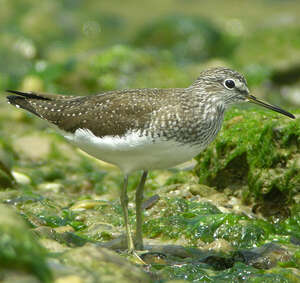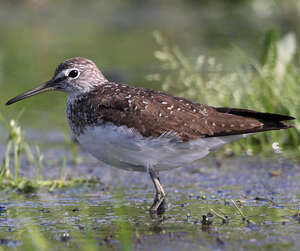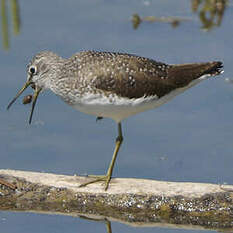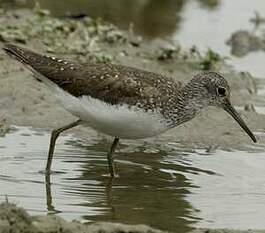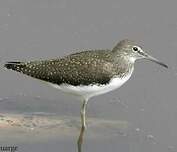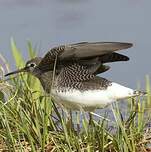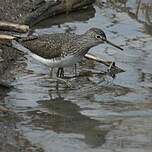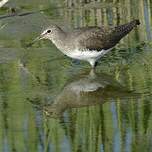Green Sandpiper
Tringa ochropus - Chevalier cul-blanc Chevalier culblanc
Identification
Often the question posed by ornithologists at the times of migration is: is it a Green Sandpiper or a Common Sandpiper? At a distance and without its voice, this can be a problem to solve through comparison.
The Green Sandpiper is a little bigger, bulkier and slightly longer-legged than the Common Sandpiper. Its plumage is also more contrasting with a darker upperpart and a brighter whitish underpart; this is particularly visible when in flight. From above, the white rump and the white leading edge of the tail feathers, which give its English name, match with the dark back and the barred pattern on the tip of the tail. From below, the dark underside of the wings contrast with the white body (a lesser contrast is visible above and no contrast is visible below in the Common Sandpiper). Among the seven species of sandpipers found in the European area, this is the only one with a dark underside of the wings.
During the spring migration, birds are in the breeding plumage. The Green Sandpiper has a deep blackish brown upperparts with a fine light barring (while the Common Sandpiper has a lighter one with more whitish and beige barring). Its underparts are pure white including the flanks, which also have some dark markings on the anterior edges (the Common Sandpiper has buffy-cream flanks with many dark spots). The head, nape and upper chest are darkly streaked (in the Common Sandpiper, this area is much paler and lacks the 'breastplate' effect). It has a very visible white eye-ring and a feeble whitish supercilium over the black loral area (in the Common Sandpiper, the supercilium is a complete whitish one creating a dark 'cap'). Finally, its legs are greenish (yellow-green in the Common Sandpiper). In the autumn migration, those characteristics remain valid. The upperparts are only slightly more uniform.
The chick is covered in gray-brown down with blackish streaks and whitish underneath.On either side of the head, a black stripe starts at the beak and runs through the eye. The juvenile resembles the adult breeding bird, but the upperparts are spotted with beige rather than whitish and the flanks are all white with no markings in front.
Subspecific information monotypic species
Foreign names
- Chevalier cul-blanc,
- Andarríos grande,
- maçarico-bique-bique,
- Waldwasserläufer,
- erdei cankó,
- Witgat,
- Piro piro culbianco,
- skogssnäppa,
- Skogsnipe,
- kalužiak perlavý,
- vodouš kropenatý,
- Svaleklire,
- metsäviklo,
- Witgatruiter,
- xivita comuna,
- Trjástelkur,
- samotnik,
- meža tilbīte,
- pikasti martinec,
- Черныш,
- Trinil hijau,
- クサシギ,
- 白腰草鹬,
- นกชายเลนเขียว,
- 白腰草鷸,
Voice song and call
The usual call is a typical Tui Tuit Tuit that identifies the species. The song, emitted during the mating flight, has the same tonality as the call and can be written as tjudi pieu ibi pieu ibi pieu ibi.... It is not emitted during migration. The alarm call at the breeding site is a percussive pik repeated as long as the danger persists.
Habitat
During the breeding season, the Green Sandpiper inhabits the forested swamps and bogs of the taiga, the floodplains, alder and other hygrophilous forest characteristics, as well as the mountain moist forests.
During migration and winter, it looks for the edge of the water, even small water points such as drainage ditches in swampy area, and even under a canopy of trees; in this it stands out from other waders and rarely associates with them. It can also be found along the shores and islands of rivers, artificial water bodies such as treatment plants and other lagoon. Along the coast, it can be observed in ports, coves and other sheltered places, at low tide.
Behaviour character trait
The Green Sandpiper is a shy species that takes off with a cry at the slightest alarm. It is an early postnuptial migrant.
Females are the first to leave in early June to the south, even before their young are able to fly, probably due to a physiological imperative. They are followed by males and then juveniles who are the last to leave in July-August. The return journey takes place gradually from March to May.The Green Sandpiper usually occurs alone or in very small groups, more numerous in favourable resting places. It mixes little with other wading birds except the Common Sandpiper.
The major uniqueness of the Green Sandpiper during the breeding season is, as we shall see later, its arboreal nesting. The female lays her eggs in an old nest of another species in a tree. This could for example be an old, somewhat depressed, squirrel nest located at the end of a branch 20 m up in a tree, an extreme case to be sure. Let us imagine what happens at hatching. The chicks are nidifugious and leave the nest at the latest the day after hatching, once their down is completely dry and their feet steady. As for their wings, they will not serve much for the descent which will be more like a fall. The picture is clear. It's better for them not to be afraid of heights.
Flight
Dietfeeding habits
The Green Sandpiper's diet is almost exclusively composed of invertebrates. During inter-nuptial season, it stands out from other shorebirds, except for the Common Redshank, which prefer open wetlands to feed in sheltered or close proximity to vegetation.
For example, it can be found at the edge of canals, drains, ditches, on the stony or muddy banks of rivers and ponds, among the naked roots of hedgerow trees, etc. It seeks out oligochaete worms, small molluscs, crustaceans, aquatic insect larvae, etc. from time to time. In spring, on its nesting site, it draws its resources from its humid forest environment. Its diet is mainly insectivorous and consists of insects and spiders. It is supplemented with fry and amphibian larvae.Reproduction nesting
The Green Sandpiper is monogamous and only has one brood a year, although nesting can begin quite early.
In fact, in the southern part of its range, adults are present on the site as early as April. Egg laying can occur between mid-April and late June, depending on the latitude.The species nests in wooded marshland as nesting is arboreal, unique among our waders. In fact, the bird does not build its own nest; the female lays her eggs in an old nest of another species such as a pigeon, thrushes, or a squirrel, sometimes even up in a high tree. On occasion, she may also lay directly on a branch in a depression, or on the ground between the roots if there is no other choice.
The clutch consists of 4 olive-brown speckled eggs with an incubation period of 20-23 days, mainly done by the female. The arrangement of the 4 conical eggs, with the pointy end facing towards the centre of the nest, is typical of waders (see illustration by Gould). This is a great advantage for nesting without a nest.
The chicks are covered with gray-brown down. It must be quite challenging for them to find themselves on the ground after a probably rough fall. They will fly at the age of 4 weeks and the female may leave the area even before her young are ready to fly.
Geographic range
The Green Sandpiper breeds across almost the entire length of the Eur-Asian continent, from the North Sea and Scandinavia to the Russian Sea of Okhotsk, in temperate and boreal latitudes. It does not nest in Iceland or the British Isles.
Its wintering range is completely disjoint. The species winters in temperate west Europe, around the Mediterranean Sea, in sub-Saharan Africa and along the Nile, in Minor Asia around the Arabian Peninsula, on the Indian continent, in Southeast Asia up to the Philippines and northern Borneo, and finally in southern China and Japan.
Threats - protection
Sources of information
- IOC World Bird List (v15.1), Gill, F and D Donsker (Eds). 2025-12-07.
- Limicoles, gangas et pigeons d'Europe, Paul Géroudet (mise à jour Georges Olioso)
- Shorebirds, an identification guide to the waders of the world, Peter Hayman, John Marchant Tony Prater
- Avibase, Lepage Denis
- Birds of the World, The Cornell Lab of Ornithology
- xeno-canto, Sharing bird sounds from around the world,
Other sources of interest
 Specification sheet created on
03/10/2023 by Jean François
Specification sheet created on
03/10/2023 by Jean FrançoisTranslation by AI Oiseaux.net
© 1996-2026 Oiseaux.net
- Accipitriformes
- Aegotheliformes
- Anseriformes
- Apodiformes
- Apterygiformes
- Bucerotiformes
- Caprimulgiformes
- Cariamiformes
- Casuariiformes
- Charadriiformes
- Ciconiiformes
- Coliiformes
- Columbiformes
- Coraciiformes
- Cuculiformes
- Eurypygiformes
- Falconiformes
- Galliformes
- Gaviiformes
- Gruiformes
- Leptosomiformes
- Mesitornithiformes
- Musophagiformes
- Nyctibiiformes
- Opisthocomiformes
- Otidiformes
- Passeriformes
- Pelecaniformes
- Phaethontiformes
- Phoenicopteriformes
- Piciformes
- Podargiformes
- Podicipediformes
- Procellariiformes
- Psittaciformes
- Pterocliformes
- Rheiformes
- Sphenisciformes
- Steatornithiformes
- Strigiformes
- Struthioniformes
- Suliformes
- Tinamiformes
- Trogoniformes



